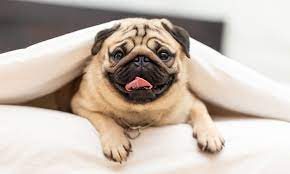Pugs are really big dogs in small bodies. With their distinctive construction, wrinkled forehead, and glowing eyes, these dogs are quite talkative and can express a range of emotions. They are playful, stubborn, and good for many pet families. Thus, their attractive faces come with some potentially serious health issues.
Thinking that Pug is the right dog for you? Read on to find out more about this popular brand, including body image, character, maintenance requirements, history, and more.
Pug Characteristics
Shape
Despite their strong construction, the Pugs are members of the toy genus. Their bodies are square, with large legs, but their heads are large and round, with a short mouth, and a frown. Their eyes are dark, shiny, and sleek, which makes them vulnerable, and the tail curves slightly above the hips. Pugs have a short but thick double coat that comes in different colors: silver, black, fawn, and apricot.
Qualities and attitudes
Unlike other types of toys, Pugs do not work very well but they do this with their great imagination! True to the motto of the genus “multum in parvo,” it means more small, Pugs large dogs in a small package. Thanks to their chosen brow, they are able to display a range of expressions which makes them very interesting friends.
Pugs can sometimes be stubborn but often need to be fun. Most of them are good with children and often get along well with other pets. They enjoy socializing and can be very affectionate, which makes them great companion dogs. Pugs are sleepy dogs, rarely barking or chewing on prey as long as they are given emotional and physical stimulation.
Long life
The average life expectancy of Pugs is 12-15 years. The average lifespan of male pugs is 12.8 years, while female pugs expect a life expectancy of 13.2 years. Your pug can live more than 15 years in good conditions. For example, the oldest American Pug, King Tug the Pug, is 18 years old.
History of Pug
The Pug is one of the oldest breeds of dogs, dating to about 400 BC. It is believed that the breed originated in China and originated with the Mastiff or Bulldog.
During the 1500s and 1600s, Pugs became popular among the elders and royal families of Europe. William and Mary of Orange came with their Pugs when they came to England to take over the kingdom and began to be really mad at the nation among the British. Queen Victoria Marie Antoinette, and Napoleon’s wife, Josephine, along with many other Spanish officials, both owned and loved Pugs.
In 1860 a new Pugs was brought from China to England. These had short legs and a slightly different nose, contributing to the Pug appearance we know today. Pugs were brought to the US after World War I, and the breed became known by the AKC in 1885. Today, according to the American Kennel Club, Pugs are ranked 28th on the list of popular breeds.
Pug Care
Initial contact and dog classes are encouraged. Because these dogs love to entertain they are often easy to train. However, their emotions are easily hurt, so harsh teaching methods should be avoided.
Exercise
As mentioned earlier, Pugs are not very active dogs and they do not bother to spend a lot of time lying on the couch. Thus, a lack of exercise combined with the type of appetite for food can lead to obesity easily. Pugs are also lively and playful so they enjoy moderate daily activities such as backyard games or walking. It should be noted, that Pug Breeders are not tolerant of hot weather, so they should be very protective of the outside weather during the hot summer days.
Beauty
Pugs are short, sleek, and shiny coats that require little adjustment. Therefore, they shed so you will have to scratch your dog once or twice a week to remove loose hair. Pugs do not need to be washed unless they are very dirty or smelly, but their nails should be cut regularly. The wrinkles on their faces should also be kept clean; a gentle wipe with a damp cloth daily should be sufficient.
Nutrition
Pugs should be fed up to half a cup of dry dog food twice a day. Thus, the amount of food depends on your child’s age, size, and level of activity. As mentioned earlier, Pugs need food and can easily be overwhelmed. For this reason, you should always focus on your Pug’s daily calorie diet and avoid overeating or human consumption. Talk to your vet for tips on how to keep your dog perfect and healthy.
Staying with Pugs
Pugs want to spend time with their family and do not want to be alone for long. They are mainly domestic dogs and are good with children and other pets. Due to their economical nature, they do not need to be too hot and hot and should be carefully monitored for heat. Pugs often snore, also as a result of shortness of breath and shortness of breath.
Key Takeaways
- Pugs are strong and resilient dogs with an easy-going nature. They are known for being friendly, which makes them ideal for families with children.
- Pugs are easily adapted to any living environment. With only moderate requirements for exercise, Pugs are standard at home in an apartment or house with a yard whenever exercise is provided.
- Because of their short stature, Pugs tend to have a number of health issues, so you should be prepared to regularly visit the vet for preventive care.








